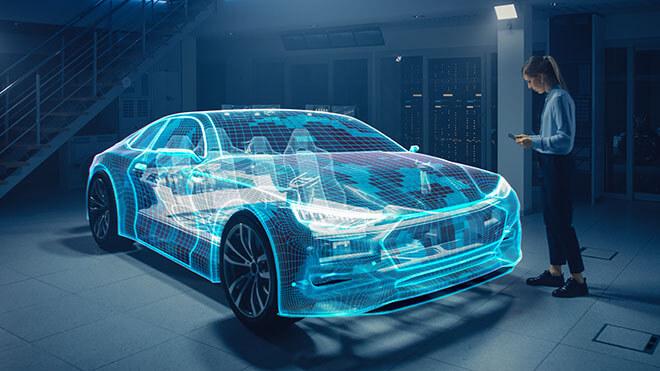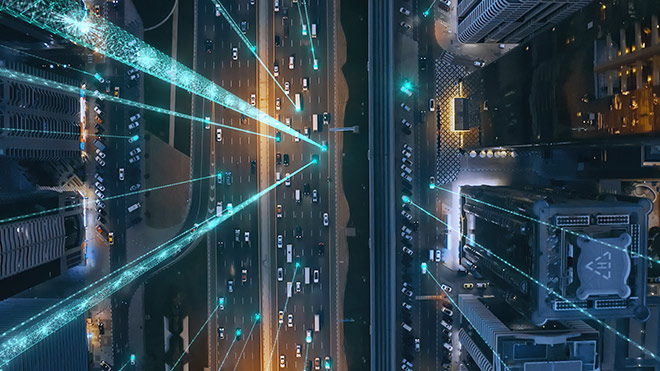Outline
- Transport Innovation #1: Connected Vehicle Technologies
- Transportation Innovation #2: Smart Road Technologies and Intelligent Transportation Systems
- Transportation Innovation #3: New Driving Data Intelligence
Innovation for road safety is strong, and includes connected cars, connected roads and data intelligence. For a DOT, the most effective and operational road safety innovations are not necessarily the most spectacular. Behind the showboating, there are also more accessible, concrete revolutions. Here is a roundup of some of the latest road safety innovations, and which of them offers the most reliable and promising immediate difference to enhancing road safety.
Transport Innovation #1: Connected Vehicle Technologies
 From merely connected to fully autonomous, new-generation vehicles aim to deliver improved road safety, better traffic management, reduced emissions and travel costs, and more comfort. Regardless of the technology used, achieving those goals requires investment in infrastructure and manufacturing technologies, and is still years away from becoming mainstream. Yet, pilot programs are currently being run to test feasibility and results.
From merely connected to fully autonomous, new-generation vehicles aim to deliver improved road safety, better traffic management, reduced emissions and travel costs, and more comfort. Regardless of the technology used, achieving those goals requires investment in infrastructure and manufacturing technologies, and is still years away from becoming mainstream. Yet, pilot programs are currently being run to test feasibility and results.
Vehicles Connected to Pedestrians, other Vehicles and Infrastructure
Brimming with a network of technologies, a connected vehicle is able to exchange and handle an enormous amount of data. Information travels both ways, between the vehicle to pedestrians (V2P), other vehicles (V2V) and infrastructure (V2I). Speed, congestion, road conditions, roadworks, accidents and parking information help drivers adjust their speed and route.Algorithms for Autonomous Vehicles
Beyond connectivity, driverless cars vehicles also include algorithms that help them predict, plan and control their movement to navigate safely by themselves within their surroundings.Examples in New York City and Las Vegas
New York City has deployed a connected vehicle pilot program in three areas in Manhattan and Brooklyn. Large fleets of city and commercial vehicles are connected, to measure how effectively they reduce traffic fatalities. As of 2023 in Las Vegas, Lyft users will be able to hail an autonomous ride.Requirements and Feasibility?
Cellular, cloud or WiFi networks are necessary for connected and autonomous vehicles to operate in. To address a DOT’s road safety concerns, road maintenance and upgrade programs need to plan now and implement complex networks in order to be ready for the connected and autonomous vehicles that will be available in the future. It is exciting to think of streets that communicate directly with us and vehicles that conduct themselves intelligently through a multitude of variables. However, it will be some time before connected and autonomous vehicle technology becomes the norm.The road safety they promise is still years away.Transportation Innovation #2: Smart Road Technologies and Intelligent Transportation Systems

Traffic Lights
- Camera Data in Hamburg
- Algorithms in London
Smart Pavement
- Solar Road Paint in the Netherlands
- Connected Roads in Colorado
Requirements and Feasibility?
Each of these innovations requires investing in changing infrastructure to roll out on a large scale. Realistically, it is unlikely that DOTs will invest in transforming all roads everywhere to these new technologies. The sheer magnitude of existing infrastructure makes it a tough task for local governments. What is more likely is that innovations like these will be used in areas that are already known to be part of the “High Injury Network”. In terms of road safety, they do not necessarily provide any new information that can help prevent road accidents. And it is only by preventing accidents that road safety is improved.Transportation Innovation #3: New Driving Data Intelligence

Aggregating and Analyzing all Driving Data
With driving data, it’s possible to identify where there are near misses and potentially risky road zones. Contextualizing the data goes even further in terms of understanding what is at play:- Road segments where harsh braking occurs at night and not during the day
- An intersection where hard acceleration takes place at specific times
- A turn that becomes dangerous in wet road conditions
- Distracted driving along a busy turnpike coming into an urban area
Data-Driven Insights
Understanding this driving behavior as a result of intelligent driving data results in actionable insights that can produce immediate results for road safety. For each of the examples above:- Adding more light to improve night-time visibility
- Adjusting traffic light cycles to smooth out traffic
- Improved signalization to reduce speed
- Better directions to locations the turnpike serves
Requirements and Feasibility?
We saw above that autonomous and connected cars won’t be here for a few years yet. And that changing infrastructure is a long and costly undertaking, that most likely will only take place on a limited scale. Driving behavior data, on the other hand, has three main advantages:- No infrastructure changes are involved
- Driving behavior data provides exhaustive coverage of any given area
- Driving data can be leveraged immediately and at a reasonable cost.


